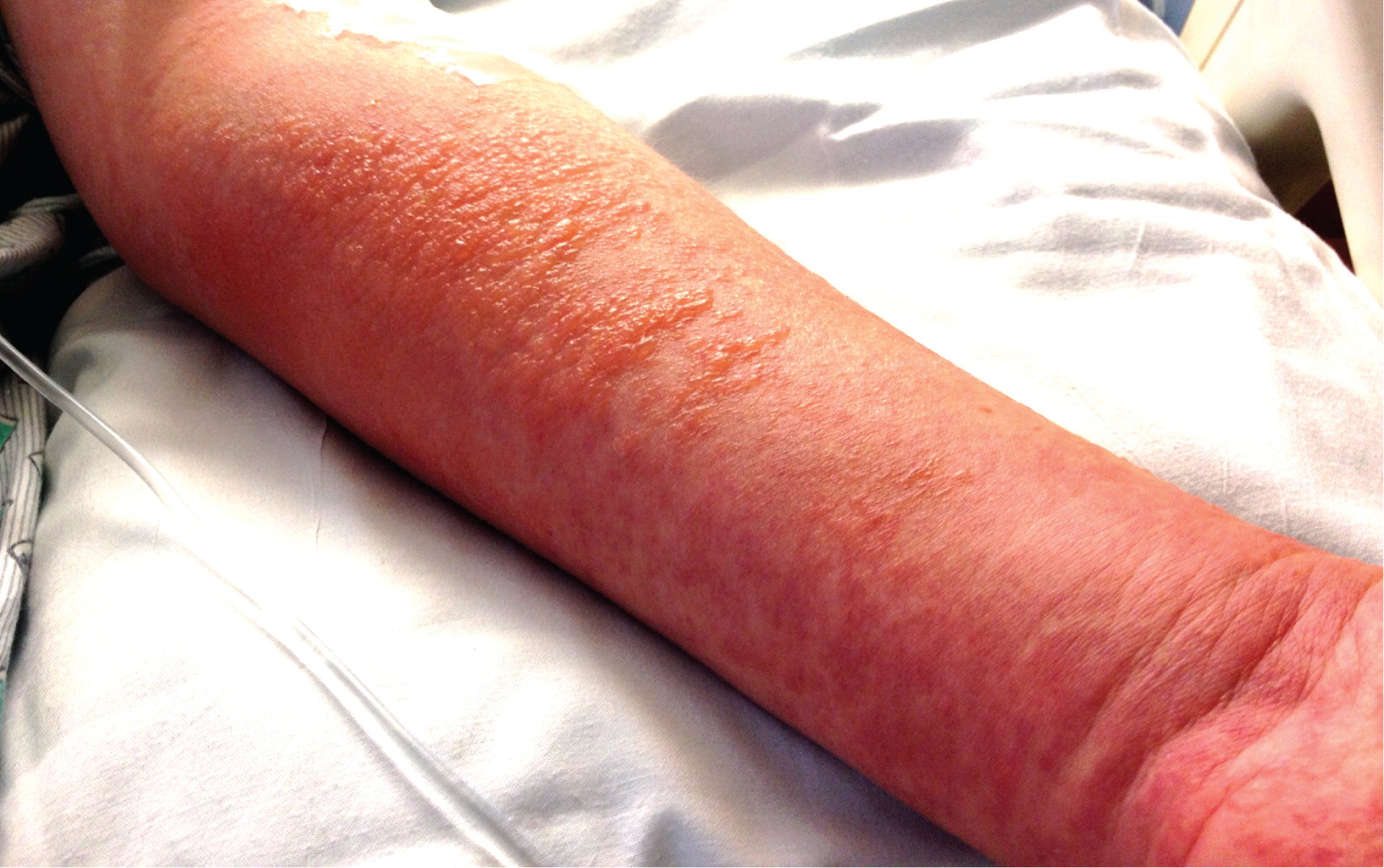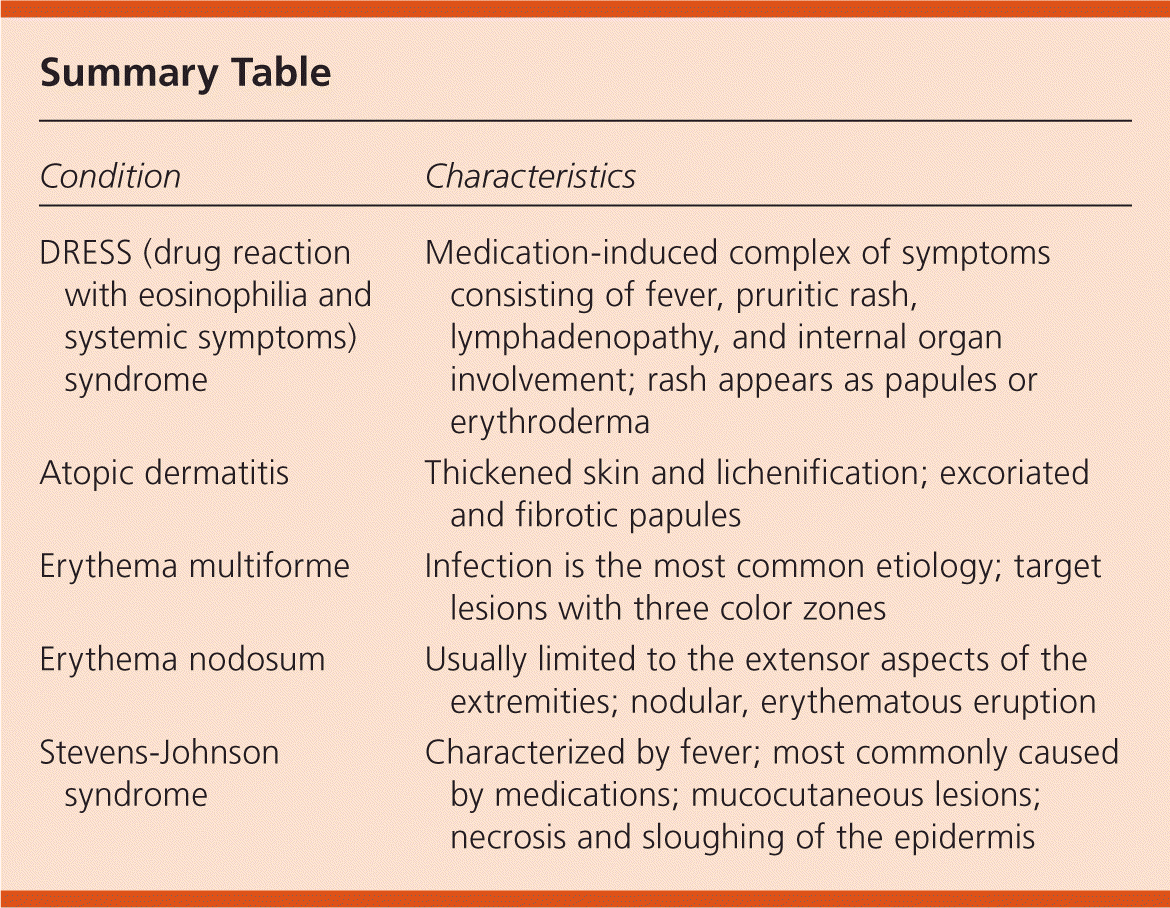
This is an updated version of the Photo Quiz that appeared in print.
Am Fam Physician. 2014;89(3):213-214
Author disclosure: No relevant financial affiliations.
A 54-year-old woman presented with a pruritic rash that developed one week earlier. She also had fatigue and fever. She had a history of asymptomatic hyperuricemia and began taking allopurinol (Zyloprim) one month earlier. On physical examination, she had an erythematous maculopapular rash with vesicles on her chest and upper extremities (see accompanying figure). She had leukocytosis and eosinophilia, and her liver function test results were elevated.

Question
Discussion
The correct answer is A: DRESS (drug reaction with eosinophilia and systemic symptoms) syndrome, also known as anticonvulsant hypersensitivity syndrome. This syndrome is a medication-induced complex of symptoms consisting of fever, pruritic rash, lymphadenopathy, and internal organ involvement. It is associated with several anticonvulsant medications, as well as allopurinol, sulfonamides, and other medications.1 Laboratory abnormalities include hepatitis with leukocytosis and eosinophilia.2 Patients usually have a macular or papular rash or erythroderma; pustules are rare.2 Management includes discontinuing the offending agent and initiating supportive systemic steroids.
Atopic dermatitis is a chronic inflammation of the skin that is common in children. It is characterized by pruritus, and exacerbations and remissions. Patients develop thickened skin, increased skin markings (lichenification), and excoriated papules. Diagnosis relies on a history of exposure to certain irritants or allergens.3
Erythema multiforme is a relatively common, acute, self-limited, and sometimes recurrent inflammatory disease. Herpes simplex virus infection is the most commonly identified precipitant, followed by Epstein-Barr virus infection,4 but erythema multiforme can also be a reaction to medication. Symmetric, erythematous, target-or iris-like papules and vesiculobullous eruptions appear on the extremities, palmar surfaces, and plantar surfaces within days of exposure.4 Mucosal lesions may occur in up to 70% of cases, often on the lips and buccal mucosa.2

| Condition | Characteristics |
|---|---|
| DRESS (drug reaction with eosinophilia and systemic symptoms) syndrome | Medication-induced complex of symptoms consisting of fever, pruritic rash, lymphadenopathy, and internal organ involvement; rash appears as papules or erythroderma |
| Atopic dermatitis | Thickened skin and lichenification; excoriated and fibrotic papules |
| Erythema multiforme | Infection is the most common etiology; target lesions with three color zones |
| Erythema nodosum | Usually limited to the extensor aspects of the extremities; nodular, erythematous eruption |
| Stevens-Johnson syndrome | Characterized by fever; most commonly caused by medications; mucocutaneous lesions; necrosis and sloughing of the epidermis |
Erythema nodusum is a nodular erythematous eruption usually limited to the extensor aspects of the extremities. The characteristic lesions begin as red, node-like swellings over the shins, and commonly affect both legs.2 Sulfonamides, bromides, and oral contraceptives have been reported to cause erythema nodusum.2 It is also associated with streptococcal infections and some cancers, such as lymphoma.
Stevens-Johnson syndrome is a severe idiosyncratic reaction, most commonly triggered by medications, and is characterized by fever and mucocutaneous lesions leading to necrosis and sloughing of the epidermis. Oral lesions such as mucosal blistering may precede skin lesions. The skin lesions are flat, atypical target lesions characterized by blisters or purpuric macules.5
